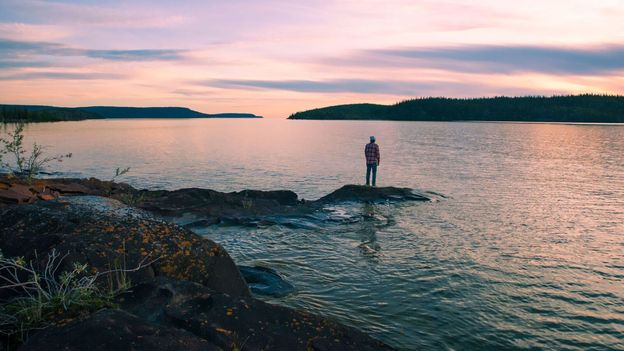In Canada, centring conservation with the country's indigenous peoples is allowing its original stewards to reconnect to their land and culture – and proving remarkably effective.
Every year, when the frozen streams have melted and greenery emerges after months of winter stillness, Dolcy Meness knows it's time. Packing their truck, she and a colleague set off through the densely forested hills of Kitigan Zibi Anishinabeg territory, an Algonquin First Nation in the province of Quebec.
After a few hours they reach their destination. Parking the truck, they make their way through forest until reaching a narrow stream. Kneeling on its mossy bank, Meness carefully places a small device in the water.
Over a period of one year, the device will collect data on the water's temperature, PH, salinity and conductivity.
But even before any data is gathered, Meness and her colleague are on the look out for indications that something is off. Seeing an unusually high amount of sand in streams – which leaks into the water from logging roads – is one sign they look out for, based on indigenous knowledge, says Meness.
"Brook trout use creeks, but they like rocks. Sand isn't a good breeding place for them, so they have to look for a different place. It creates a change that shouldn't be there," she says.
Using a "two-eyed seeing approach", Meness and fellow Nagadjitòdjig Akì guardians draw on the strengths of indigenous knowledge alongside Western science to monitor the impacts of extractive industries, like logging, on their territory.
Being in this job gives me in-depth knowledge about my own history, culture and teachings. [It's] a long journey of re-learning – Dolcy Meness By collecting data on water quality in streams and rivers, they help determine if companies are adhering to regulations.
"We can go to them and say: 'You're not doing your job properly, you're destroying creeks when you're logging, you're not following your own rules,'" says Meness.
Over the year, Meness and her colleagues will repeat their data gathering task many times. Working alongside non-governmental organisations, they're responsible for 50 sites throughout the Ottawa River watershed, which encompasses Kitigan Zibi traditional territory.
They are also part of a flourishing movement of 1,000 "Indigenous Guardians" across Canada who are stewarding their traditional lands and waters and redefining what conservation can – and many argue should – look like.
Amidst global ecological collapse, which some scientists call the "sixth mass extinction", there is increasingly widespread acknowledgement that indigenous people can demonstrate a more sustainable path forward – one that other societies could learn from. This is due to both their relationship with the environment, based on respect and reciprocity, and their substantial but often undervalued contributions to biodiversity conservation.
In Canada, where there are feelings among many that colonialism is a historical problem but one still rooted in the present, centring conservation with the country's original stewards is allowing indigenous people to reconnect to their land and culture. It is also reshaping relations between indigenous nations and non-indigenous Canada, presenting an opportunity for genuine reconciliation.
"Being in this job gives me in-depth knowledge about my own history, culture and teachings," says Meness. "[It's] a long journey of re-learning."


